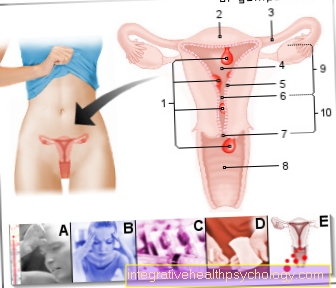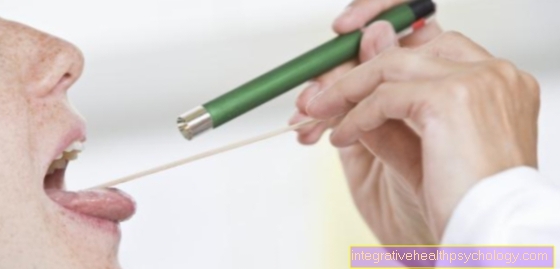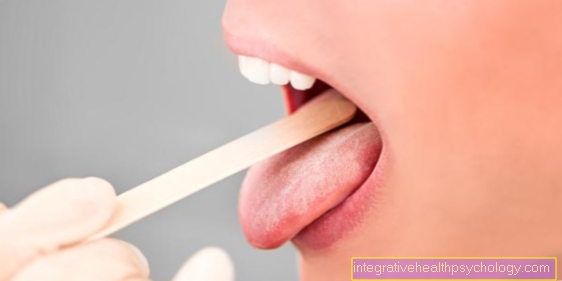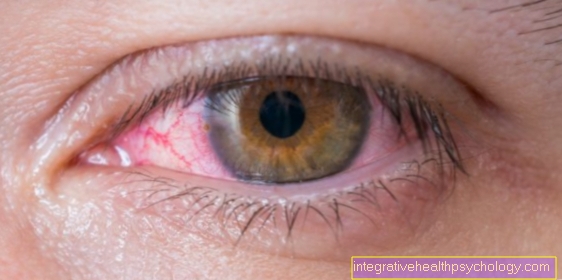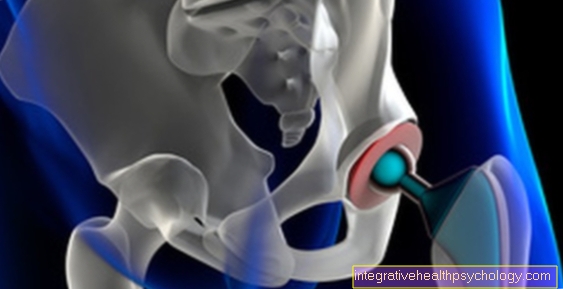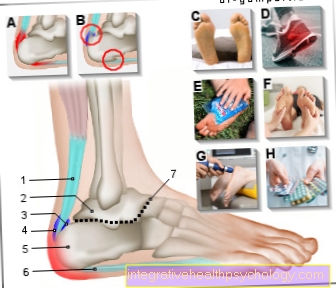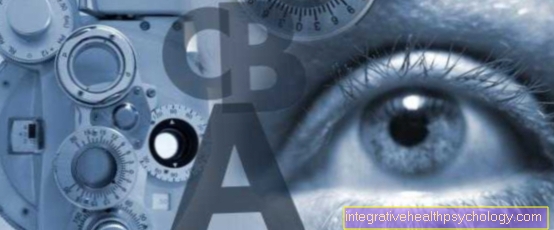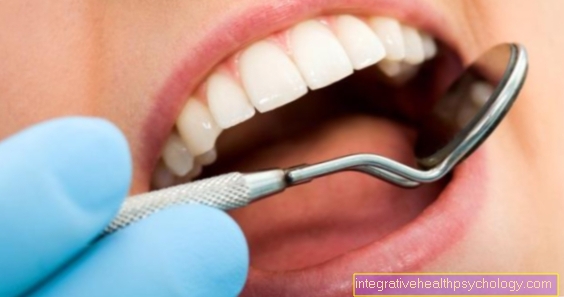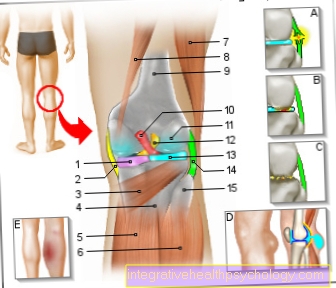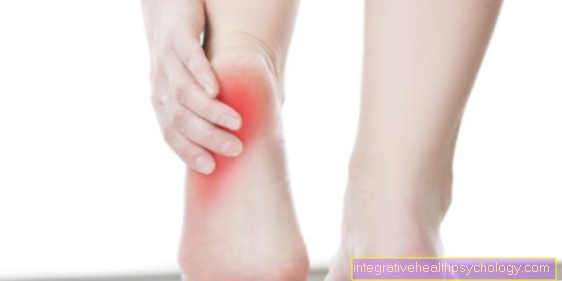Antihistamines
synonym
Antiallergic drugs
What are antihistamines?
Antihistamines are therapeutically used substances that weaken the effect of the body's own messenger substance histamine. Histamine plays i.a. a central role in allergic reactions, inflammation, sensations such as nausea and in the regulation of the sleep-wake cycle.
Especially when treating allergies, such as Antihistamines have become indispensable for hay fever. Antihistamines are also very effective drugs for the symptomatic treatment of motion sickness (for example with Vomex®). Many preparations are available in pharmacies without a prescription.

Where does histamine occur?
histamine occurs in many tissues in the body. It becomes from the amino acid Histidine is formed and stored in so-called mast cells. The release can occur through the body's own and external factors. Once released, histamine works by attaching to histamine receptors. Histamine is particularly highly concentrated in the mucous membranes Stomach and the Bronchi as well as in the skin. Lower histamine concentrations are found in blood cells, the so-called basophilic leukocytes and Platelets. Histamine also plays a role as a signal transmitter in the central nervous system.
You can find more information on the topic at: histamine
What is histamine used for?

histamine is a messenger substance. It is used in tissue damage, like sunburn, Burns, cuts, bruises etc are released from the affected cells. As a result, surrounding blood vessels expand in order to ensure better blood flow to the damaged tissue and to increase the permeability of the blood vessel walls. As a result, components of the immune system can get into the damaged tissue, inflammatory cells migrate, destroyed cell fragments are transported away and the tissue is renewed. In the stomach, histamine increases the production of Stomach acid, In certain brain regions it serves as a messenger substance for the transmission of information between Neurons. It affects the sleep-wake cycle, nausea and Vomit.
Which factors lead to the release of histamine?
Histamine can be triggered by mechanical stimuli, e.g. pressure on tissue, but solar radiation and heat can also have this effect. In addition, certain substances can cause histamine to be released into surrounding tissue. These substances can be endogenous hormones such as gastrin on the one hand, and foreign substances such as insect poisons, drugs or so-called antigens on the other. Antigens are substances that provoke a defensive reaction in the body. Many people today suffer from an overly sensitive immune system. They are very sensitive to contact with certain substances, such as Bee pollen, house dust, food, cosmetics etc. bind antigens to cell surfaces, e.g. an inhaled pollen on cells of the nasal mucous membrane, the antigen "pollen" is recognized as foreign by the immune system. The cell is destroyed and the histamine it contains is suddenly released. For allergy sufferers, this release of histamine is noticeable in different forms, for example through reddening of the skin with wheals, swelling of the mucous membranes of the upper and lower airways or through itching.
Types of histamine receptors and their effects
Histamine mediates its effect by binding to a histamine receptor after its release from the mast cells on neighboring cell surfaces. This signal usually causes the cell to activate or deactivate certain processes by sending out further messenger substances. There are 4 different types of histamine receptors: H1, H2, H3 and H4.
If histamine binds to an H1 receptor, this mediates the following effects in varying degrees: blood vessels contract, the vessel walls become more permeable, mucous membranes swell, the bronchi in the lungs constrict, the skin shows reddening and forms as a result of the increased blood flow possibly small wheals. Excessive release of histamines, such as those caused by allergic reactions or hives (Urticaria) is the case, is usually accompanied by annoying itching. Itching is caused by histamine-stimulated nerve endings in the skin.
H1 receptors are also found in the brain. There histamine acts as a transmitter between nerve cells and influences the sleep-wake rhythm. On the one hand, it is involved in the wake-up reaction and increases the wakefulness. On the other hand, it controls the feeling of nausea and nausea.
Please also read our article on this Nausea
H2 receptors are mainly found in the gastrointestinal tract. Histamine is stored in what are known as ECL cells (enterochromaffin-like cells). The cells can be stimulated to release histamine by the hormone gastrin. The histamine then binds to H2 surface receptors on neighboring parietal cells, whereupon they produce stomach acid and thus promote digestion. In addition, the activation of H2 receptors leads to an accelerated heart rate and the contraction of blood vessels.
If histamine binds to H3 receptors, this has a self-regulating effect on the release of histamine. Activated H3 receptors inhibit the release of histamine in the brain and regulate the release of other messenger substances. This controls hunger, thirst, day-night rhythm and body temperature.
H4 receptors have not yet been adequately researched. But there is evidence that they play a role in allergic asthma.
Of the histamine receptor types described above, only drugs that bind to H1 and H2 receptors are on the market so far; the so-called H1 or H2 antihistamines.
Antihistamines
The term "Antihistamines“Means something like“ drugs that counteract histamine ”. It works as follows: the respective active ingredients compete with the body's own histamine for the binding site at the receptor on cell surfaces.
The active ingredient usually has better binding capacity and can displace the body's own histamine from the receptor. Unlike histamine, however, the bound active ingredient does not trigger a reaction. It only blocks the binding site so that the histamine-typical effect does not occur.
H1 antihistamines cancel the effects of histamine on H1 receptors. This is particularly important in the case of allergic diseases such as hay fever, non-infectious itchy skin conditions such as hives (Urticaria) or insect bites are desirable. In this way, these complaints can be effectively alleviated. However, this is only a temporary, symptomatic treatment. The cause cannot be eliminated in this way.
The class of H1 antihistamines has been continuously developed. Therefore, the associated active ingredients are divided into H1 antihistamines of the first, second and third generation. The disadvantage of the first generation H1 antihistamines is that they act not only on H1 receptors, but also on other types of receptors. This can cause side effects such as dry mouth, headache, dizziness, nausea or tiredness. The latter, in turn, has been made therapeutically useful. Some of the first generation H1 antihistamines are also used as calming (sedating) agents to promote sleep. Some active ingredients, which are also part of the first generation of H1 antihistamines, show pronounced effects against the symptoms of motion sickness, such as nausea and vomiting. Second-generation H1 antihistamines have hardly any sedating side effects and are primarily anti-allergic.
Read more about this under Anti-Nausea Medication
2nd generation antihistamines
The first generation antihistamines were further modified for antiallergic therapy. A major disadvantage of the old antihistamines (e.g. Clemastin, Dimetinden) was the sleep-promoting side effect. For this reason, the substances of the second generation have been changed so that they can no longer lead to increased fatigue in the central nervous system.
As a result, the second generation antihistamines are primarily characterized by a strong antiallergic effect. As part of an allergic reaction, the swelling is greatly inhibited and itching and pain are reduced. In addition, the antihistamines cause the bronchi to expand slightly.
The best-known active ingredients of the second generation include cetirizine and loratadine. Terfenadine, which was frequently used for a long time, has led to considerable cardiac rhythm disorders and is therefore no longer approved for the market in Germany.
application areas
H1 antihistamines are a very important class of drugs used to treat Allergies. They are effective in relieving symptoms such as itchy, watery ones eyes, swollen nasal mucous membranes with the feeling of congestion nose, itchy nose with the associated urge to sneeze. H1 antihistamines are also used in Skin manifestations such as itching, wheals and reddening of the skin, such as with allergies, with chronic urticaria, sunburn, light Burns and insect bites are encountered. The second generation lacks the sedative, drowsy effect. Therefore, active ingredients of this generation are given preference nowadays if this effect is not desired. Another area of application is Histamine intolerance.
Some of the active ingredients of the first-generation H1 antihistamines have a calming effect on nausea and vomiting. That's why they can help preventively travel sickness or be taken in case of nausea and vomiting. In the case of some H1 antihistamines, the antiallergic effect takes a back seat compared to the sedative effect, so that they take priority as Sedatives and sleep-promoting agents be applied.
H2 antihistamines have a different field of application than H1 antihistamines. They lower stomach acid production and can be used to treat gastric acid-related ailments, such as the Reflux disease and Stomach or small intestine ulcers be applied.
Side effects of antihistamines on the heart
Individual preparations (terfenadine, astimezole) lead to considerable cardiac rhythm disorders and have therefore already been withdrawn from the market in some countries.
These substances cause a prolongation of the QT time of the heart in the ECG (spread and regression of the heart), which can lead to severe disorders of the heart rhythm with an increased risk of sudden cardiac death.
With many other preparations, there is often a significantly increased heart rate during therapy. Individual patients report a racing heart and an inner restlessness.
Side effects of antihistamines on the liver
In rare cases, side effects of antihistamine therapy also manifest themselves in the liver.
Many antihistamines are metabolized in the liver. Both activation of the preparation and excretion via the liver are possible. This puts a lot of strain on the liver, which can lead to increased liver damage if the drug is taken for a long time.
For this reason, especially when combining antihistamines with other drugs that are metabolized by the liver, attention should be paid to possible interactions. Simultaneous consumption of alcohol can also increase the effect and cause additional damage to the liver.
Side effects of antihistamines in children
Most of the first generation antihistamines are available over-the-counter in pharmacies. Often the preparations are also offered in combination with other drugs for antiallergic therapy. However, there are sometimes considerable side effects, especially in (small) children.
Since these antihistamines also accumulate in the central nervous system, it can lead to increased daytime sleepiness and a slight drowsiness. Concentration disorders are also frequently reported.
With very high doses or overdoses, hallucinations and seizures are also possible in children. Typically, the other side effects of antihistamines also occur, especially in young children. In the beginning, this leads to increased dryness of the mouth, disturbances in emptying the bladder (micturition) and constipation. In individual cases, cardiac rhythm disorders are also possible, as individual preparations lead to a prolongation of the QT time in the ECG.
In newborns and infants, there is also the risk of breathing disorders. As a result, there is a risk of cardiovascular collapse.
Do antihistamines lead to weight gain?
A rather rare side effect of treatment with antihistamines is weight change.
However, the effects of individual antihistamines on weight vary widely. While some preparations have no effect on appetite and weight, other preparations can lead to a weight gain of several kilograms within a few weeks. However, these occur mainly in long-term therapy and develop slowly and continuously over a longer period of time.
The weight gain is due to a blockade of the histamine receptors, causing a slight increase in appetite, which leads to weight gain.
Antihistamines and alcohol - are they compatible?
Many antihistamines are metabolized by the liver. Both the activation and the excretion of the preparations take place via specific liver enzymes. The liver is heavily stressed.
A combination of antihistamines and alcohol can have a mutually reinforcing effect. In addition, the function of the liver is even more stressed, which can damage the liver. For this reason, if possible, alcohol should be avoided during treatment with antihistamines. The first and second generation antihistamines in particular lead to considerable side effects when combined with alcohol.
Common symptoms when the antihistamines are combined with alcohol are increased tiredness with decreased alertness and slight drowsiness. In addition, massive impairments in concentration are to be feared. In individual cases life-threatening cardiovascular disorders can occur.
Antihistamines in Pregnancy
So far, no harmful effects on mother and child have been demonstrated for most of the common antihistamines.
Individual preparations are even used specifically during pregnancy. These include, for example, doxylamine, which is used in the treatment of vomiting.
With long-term medication with older antihistamines (diphenhydramine, hydroxyzine, dimenhydrinate) during pregnancy, few studies have shown mild withdrawal symptoms in the newborn (including increased tremors and diarrhea).
In addition, effects on the contraction of the uterine muscles have also been demonstrated. For this reason, these substances in particular should be avoided during pregnancy.
Any medication should be taken during pregnancy in consultation with the attending physician. In a few cases there is also a risk of serious risks to the child when combined with another preparation.
Antihistamines used as sleep aids
With the antihistamines of the first generation it was found relatively early that the antiallergic therapy leads to increased fatigue. The preparations inhibit the wake-up response in the central nervous system. For this reason, these substances have been further modified so that they can also be used exclusively as sleep aids.
Frequently used active ingredients are doxylamine and diphenhydramine. They are among the non-prescription sleeping pills and can especially support mild and non-chronic sleep disorders.
In order to avoid daytime sleepiness, however, attention should be paid to taking it before going to bed. The substances are usually well tolerated. Nevertheless, many side effects can occur with regular use of the preparations. These include dizziness, difficulty concentrating and headaches. Dry mouth, constipation, and urination problems are also possible.



